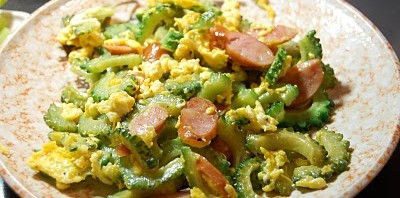
 Every country in the world has a signature dish, and if you ask any Japanese or Okinawan what Okinawa’s ‘champion’ dish is, they’ll say champuru. It would be safe to say that Okinawans would eat champuru daily, and it serves as the main dish to include everything healthy that makes up the Okinawan diet. So what is champuru?
Every country in the world has a signature dish, and if you ask any Japanese or Okinawan what Okinawa’s ‘champion’ dish is, they’ll say champuru. It would be safe to say that Okinawans would eat champuru daily, and it serves as the main dish to include everything healthy that makes up the Okinawan diet. So what is champuru?
To understand fully what champuru is, we’ll take a brief look at the history of Okinawan food culture. Okinawa is a large island between southern Japan and Taiwan. It was, for centuries, governed by the Chinese, and then invaded by the Japanese, and today is a Japanese prefecture (state). The Okinawans have always, though, held on to their culture and history, and still largely see themselves as Okinawans, and not Japanese. A point I agree with, as their language, culture, food, everything is different from Japan. This is why I focus on Okinawa as if it were another country, and not part of Japan, although it has been heavily influenced mostly by Japan.
Being under the governance of China for so long, and then Japan, it was a major trade ‘stop over’ for China, Japan, Korea and later Europeans. They all brought, traded and left their traditional and traded foods, culture, arts, etc, and Okinawa freely adopted many new things, fitting them into their own culture with ease and benefit. And as so many cultures settled, traded, lived, shared with and influenced the Okinawans for so long, their culture became and is a melting pot of variety and diversity, including its food, and ultimately champuru.
Champuru is both a dish and a concept. As a dish, it is a kind of stir fry, consisting almost always of tofu, leafy green vegetables, a local Okinawan vegetable called goya (which is quite bitter, and attributed partly to their legendary longevity), and sometimes meat.
And as champuru evolved into a ‘classic’ Okinawan dish, it also became a concept, almost a culinary symbol or metaphor for Okinawan culture and history – and that is: a little of everything from everywhere is OK, and don’t stress too much about how it’s prepared. Put a little of this in today, a little of that in tomorrow, and whatever we have the next day. This is very much part of the Okinawan way of life, and certainly their philosophy of teigei (easy-going-ness) is expressed in champuru.
I have also seen this in the traditional Okinawan martials arts, especially goju-ryu, the origins of Japanese and modern karate. While many countries, and styles, seem unwilling to accept other style’s influences into their often close-guarded systems, the Okinawans were open to learning many things from the Chinese, and later the Japanese, Koreans and Europeans. As a result, their martial arts, as well as many other aspects of their culture, became well-rounded, flexible and maintained an openness to further learning.
And herein we see the paradox that so often describes Japan and Okinawan. A seemingly slap-dash meal, with bits and pieces of this and that, but there is a ‘method in their madness’, a perfection that comes from the meal and an awareness and art that lives in the preparing, cooking and eating of champuru. The word “champuru” has also come to mean anything created by freely mixing or blending all sorts of things together, and this is referred to as the ‘champuru culture.’
Champuru is the ‘classic’ dish of Okinawa, but it is very much a strong part of Okinawan home-cooking also. And just as important, champuru is very healthy. We eat a few different kinds of champuru each week in my house. It’s easy, inexpensive and yummy!
Interested in trying champuru? Here’s a really simple way to make it:
1. Heat your frying pan well, then add tofu (a little firmer tofu works best, cut into 3–4cm cubes) and fry the tofu until golden brown.
2. Add some fresh vegetables (cooked lightly to retain their freshness and crispness) + a little sea salt (or other seasonings.)
3. If you want some kind of meat in the meal, add this to cook for a little time before the vegetables.
* As seen in the picture above, you can also add some egg and ham. At the end of the 2nd World War, Okinawa had been ‘invaded’ by the US military, who supplied the war-torn Okinawans with long-life foods such as spam, ham, sausages and other tinned foods, including beans. At that time, they had little food and no meat, due to heavy bombing (almost two thirds of the Okinawan population was killed during the final battles between Japan and the US.) But in true Okinawan adaptability and ‘champuru’ spirit, they readily adopted the new food and it quickly became part of their everyday cuisine, and sometimes still is. They are a very versatile people.
